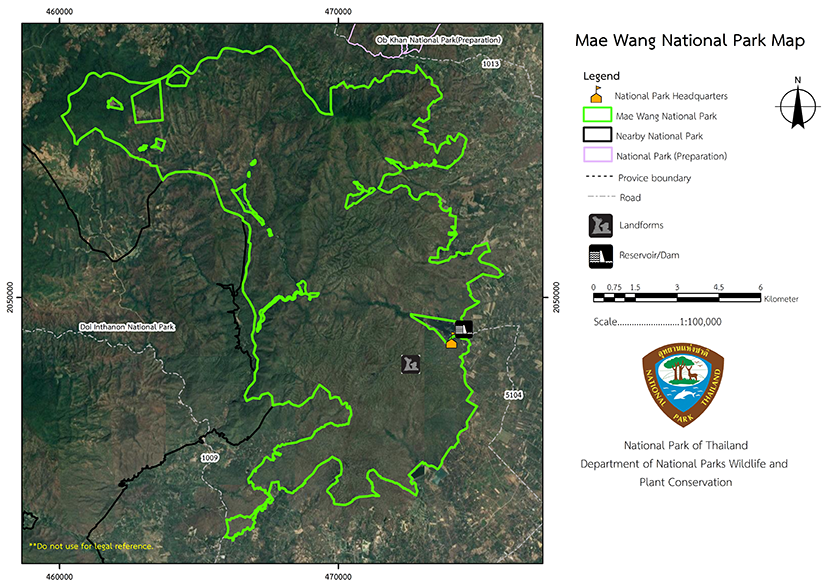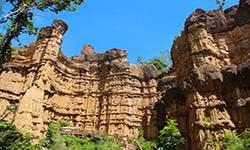Mae Wang National Park
Contact Location : Mae Wang National Park, Santisuk Sub-district, Doi Lo District, Chiang Mai Province
Telephone Number : (+66) 5 3106 759
Email : maewang.np112@gmail.com
Facebook : Mae Wang National Park
Information
- Non
Background
Op Khan National Park is located in Chiang Mai Province, and local residents reported to the Royal Forest Department in 2001 that it may be an appropriate area of national park. It was described as a National Park with fertile forest conditions and a key catchment and watershed . Due to the river’s exciting attractions and highlights, the Royal Forest Department has directed rangers to act as head of Mae Wang National Park by establishing an area within portions of the Mae Khan-Mae Wang National Reserved Forest and Chom Thong National Reserved Forest in the Chom Thong, Mae Wang, and Doi Lo District in Chiang Mai Province, totaling approximately 119 hectares.
Note : After paying the entrance fee to the National Park, please carry the receipt for inspection.
74,766 rai (120 square kilometers)
|
|
Nature trails ⇔ Geological condition ⇔ Observe flowers/plant ⇔ Forest Viewpoint ⇔ Take a photo/Video ⇔ Relax in a nature
Welfare shop : 08.30 - 16:30 hrs.
Mobile phone signal:
National Park Headquarters area: AIS, TRUE, DTAC
|
|
The Mae Wang National Park area is a fold mountain (complex mountain) located in Khao Thanon Thongchai that stretches north-south and ranges in elevation from 400 to 1,909 meters above sea level. Doi Pha Tang is the highest point, but there are numerous mountain summits with high elevations including Doi Pong Samit at 1,547 meters, Doi Hin Luang at 1,518 meters, Doi Huai Luang at 1,415 meters, Doi Mae Lip at 1,311 meters, Doi Khun Mae Sa at 1,251 meters, Doi Pha Lai at 1,245 meters, and Doi No at 1,120 meters above sea level. It is the source of three major tributaries of the Ping River, which are the Nam Mae Chaem, Nam Mae Wang, and Nam Mae Tuen.
|
|
Mae Wang National Park is influenced by the southwest monsoon, which brings moisture and rain clouds. The year-round average temperature is 25 degrees Celsius, with summer lasting from March to May, a rainy season lasting from June to November, and winter lasting from December to February. In December, the winter season, the average temperature is between 15 and 17 degrees Celsius, with a low of 10 to 14 degrees Celsius. Annual precipitation ranges between 1,000 and 1,100 millimeters.
|
|
|
|
Mae Wang ’ational Park's forest ecosystem is classified as a mixed deciduous forest that is found between 400 and 1,000 meters above sea level. Teak, Lagerstroemia calyculata Kurz, Burma Padauk, Xylia xylocarpa, Canarium subulatum, Terminalia chebula, Vitex peduncularis, Balakata baccata, Irvingia malayana, Gamari, and various bamboo species are the dominant plants. Deciduous dipterocarp forest is found at an altitude of 400 to 900 meters above sea level and the coniferous forest (pine forest) is found in areas between 900 and 1,500 meters above sea level. It is dominated by Burma Sal, Burmese Sal, Hairy Keruing, Dipterocarpus tuberculatus, and White-Meranti, with important plants are Merkus Pine (Pinus merkusii Jungh & De Vriese) and Khasiya Pine (Pinus kesiya Royle ex Gordon). Several other plants and ground plants were discovered, including Anneslea fragrans, Engelhardtia spicata, Engelhardtia spicata Lechen, Jambolan Plum, Helicia nilagirica, Lyonia ovalifolia, Melanorrhoea ustata, Schima wallichii, Castanopsis diversifolia, Evergreen Chinkapin, Quercus kerrii Craib, Chromolaena odorata. Blumea balsamifera, Ginger, Alpinia conchigera. The hill evergreen forest, which is frequently found at elevations of 1,000 meters is home to Michelia champaca, Cinnamon, Anneslea fragrans, and Betula alnoides. The wild animals found in Mae Wang National Park are Indian Muntjac, Wild Boars, Fishing Cats, Rhesus Macaque, Lar Gibbon, and Viverricula indica, the Yellow-Throated Marten, Asiatic Brush–Tailed Porcupine, Sunda Pangolin, Burmese Hare, Pallas’s Squirrel, Blanford’s Fruit Bat, Crested Serpent-Eagle, Chinese Francolin, Red Jung’efowl, Mrs. Hume's Pheasant, Barred Button Quail, Grey-Capped Emerald Dove, Green-Billed Malkoha, Asian Barred Owlet, Asian Palm Swift, Red-Headed Trogon, Oriental Pied Hornbill, Barbet, Grey-Capped Woodpecker, Black-Headed Bulbul, Black Drongo, Blue-Throated Sunbird, Big-headed Terrapin, Elongated Tortoise, Draco haematopogon, Ground Lizard, Clouded Monitor Lizard, Reticulated Python, Banded Krait, King Cobra, Striped Spadefoot Frog, Fanged Frog, Common Treefrog, and Common Asian toad. |
How to get there by car :
Take National Highway No. 108 (Chiang Mai-Hot) south from Chiang Mai city for approximately 40 kilometers to the entrance of Chan Tip market. Then continue straight for approximately 17 kilometers to the Mae Wang National Park Headquarters. It is approximately 16.5 kilometers of paved road and approximately 0.5 kilometers of gravel road. The distance is 57 kilometers in total
- Non Agency
- Non Reserve


